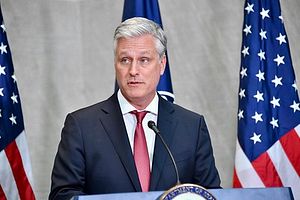The Trump administration’s last few days in Indo-Pacific diplomacy have been colossally inelegant, demonstrating the extent to which the often reassuring language that appears in its strategy documents is completely divorced from the reality of its conduct. This Monday’s ASEAN-U.S. summit in Bangkok, Thailand, laid bare the gaps in the U.S. approach to the region.
I’ve already discussed the decision to downgrade U.S. participation in the U.S.-ASEAN and East Asia Summits in Bangkok this year — a decision taken the same year the Indo-Pacific was declared the administration’s “priority theater.” With Trump’s travel to Chile for the now-canceled Asia-Pacific Economic Cooperation (APEC) summit out of the picture, the administration simply stood the risk of appearing inattentive at best and disinterested at worst in Asia.
But the self-defeating nature of the Bangkok summitry misread doesn’t end there. There’s little surprise that ASEAN officials are unhappy about the perceived snub by Washington toward this year’s summitry — a swipe at the organization’s much-cherished “centrality” in regional affairs.
Robert C. O’Brien, the new advisor to the president on national security affairs, was Trump’s envoy to this year’s summits — a downgrade from the presidents and secretaries of state that had gone in previous years. (During the Obama administration, only a single East Asia Summit between 2011 and 2016 saw a U.S. delegation led by the secretary of state.)
Japan’s Kyodo news cites an ASEAN source who notes that the group was largely “of the view that Trump should at least send a representative who is in the Cabinet.” Wilbur Ross, the commerce secretary, is a cabinet member who was in the region and slated to represent the United States at the ASEAN and East Asia Summits, but O’Brien was the lead at the ASEAN-U.S. summit on Monday.
As a result, ASEAN leaders largely snubbed O’Brien, seeing the protocol mismatch as inappropriate for a summit setting. Host nation Thailand, Vietnam, and Laos were the only three of 10 ASEAN members to send leader-level representation. The other seven member states sent foreign minister-level representation — still outclassing O’Brien.
The U.S. reaction has been predictable. Instead of expressing understanding of ASEAN’s predicament, Washington appears to be suggesting that the snub “will be seen as an intentional effort to embarrass the President of the United States of America and this will be very damaging to the substance of the ASEAN-U.S. relations,” according to an anonymous U.S. official who spoke to Kyodo about Monday’s incident.
The American attempt at damage control for now is to work toward a “special summit” with the 10 leaders of ASEAN states on U.S. soil next year — an apparent attempt to create a second iteration of Obama’s February 2016 Sunnyland special leaders’ summit. The message, however, will be unconvincing in Southeast Asia: after all, if Trump can’t be bothered to come to the region himself or ensure cabinet-level representation at the ASEAN-U.S. summit, why should ASEAN heads of state and government fly over to the United States?
At the end of all this, what is a Southeast Asian policymaker to think when reading the latest U.S. Department of State update on the Indo-Pacific, which notes that “President Donald J. Trump has made U.S. engagement in the Indo-Pacific region a top priority of his Administration”? These words can only be as credible as the administration that issues them.
































